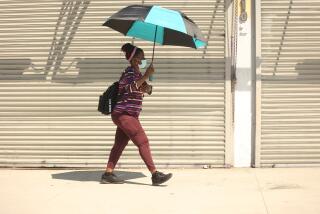Keeping Exercise Routine Out of Hot Water
How hot is too hot for exercise?
It depends not just on temperature, according to exercise physiologists from the Duke University Diet and Fitness Center.
They have developed a chart that looks at the relationship between temperature and humidity to help exercisers decide when the risks of heat exhaustion, heat stroke and dehydration make outdoor exercise foolhardy.
The chart, of course, is just a guideline. Exercisers should also listen to their bodies, cautions Peggy Keating, a Duke University exercise physiologist.
If you perceive a hot-weather workout as too stressful, she says, it probably is.
Southern Californians must also factor in smog levels, says Tom Anderson, an exercise physiologist and director of health testing at Centinela Hospital’s Fitness Institute in Culver City.
He suggests this simple guideline: “If your eyes get irritated, quit exercising (outdoors).”
Other experts suggest paying attention to symptoms like coughing and chest tightness.
When smog gets bad enough to warrant a first-stage smog alert, it’s definitely time to head indoors.
But in less-than-beastly heat and smog, outdoor exercisers can stay comfortable in a variety of ways, experts say.
* Exercise early or late in the day to avoid heat, humidity and smog.
* Keep well-hydrated.
* Drink cool rather than cold liquids. Cold drinks can shock the system, especially for people with a cardiac condition.
* Avoid main thoroughfares. Getting just one or two blocks away from main streets will cut down substantially on pollutants like auto exhaust fumes because trees and shrubs act as buffers.
* Wear as little clothing as possible. Workout wear should be made of all cotton, mostly cotton or the new breathable nylons.
Watch the Weather
Here is a look at how the relationship between temperature and humidity can affect where you should exercise. When temperature and humidity are high, exercisers can avoid risking heat exhaustion, heat stroke and dehydration by doing their workouts indoors.


